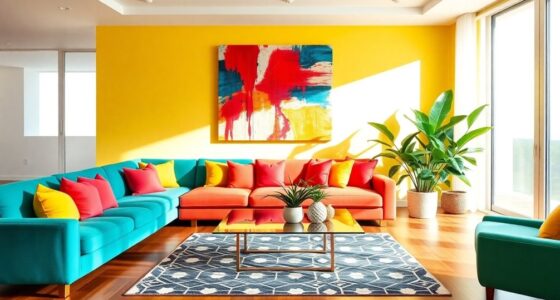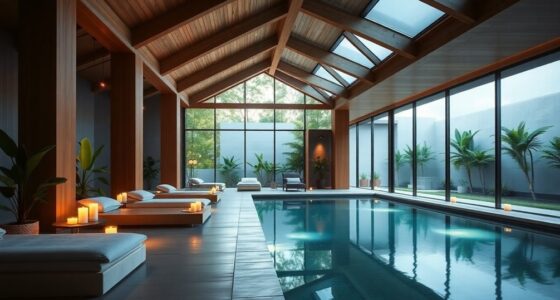Old and modern houses showcase distinct architectural styles and features. While traditional homes emphasize intricate designs and compartmentalized layouts that promote privacy, modern houses focus on open concepts that enhance space and flow. You'll find that modern homes utilize sustainable materials and smart technologies, making them more energy-efficient compared to their older counterparts. Aesthetically, traditional houses evoke nostalgia with rich materials, while modern designs reflect minimalism and functionality. Each style offers unique benefits, catering to different lifestyle needs. If you're curious about specific characteristics and advantages of each, there's more to explore in this fascinating topic.
Key Takeaways
- Old houses, like traditional homes, feature compartmentalized layouts with distinct rooms, while modern houses embrace open-concept designs promoting space flow and connectivity.
- Traditional homes use durable materials like brick and wood, whereas modern homes prioritize sustainable materials, enhancing energy efficiency with features like large windows.
- Modern homes incorporate advanced insulation and renewable energy solutions, significantly reducing energy consumption compared to the energy efficiency limitations of older houses.
- Aesthetic differences exist; traditional homes evoke nostalgia with ornate details, while modern designs focus on minimalism and functionality with clean lines and neutral palettes.
- Renovation of old houses often blends historical elements with modern amenities, while modern homes support adaptable lifestyles with features like smart technology and natural light optimization.
Overview of Architectural Styles
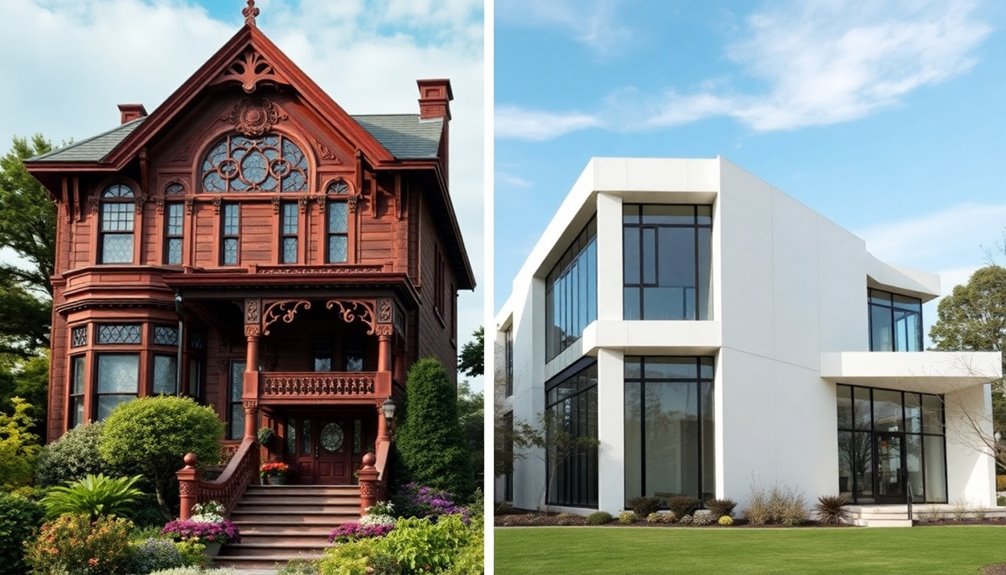
When you explore the world of architecture, you'll quickly notice a stark contrast between traditional and modern houses.
Traditional architecture often showcases historical types of houses like Colonial and Victorian, featuring intricate design elements and symmetry that connect to cultural heritage.
In contrast, modern homes embrace contemporary design, emphasizing minimalist aesthetics and practicality.
These modern structures utilize open floor plans that enhance social interaction and maximize natural light, while traditional designs tend to have compartmentalized layouts with smaller windows.
Additionally, modern homes prioritize energy efficiency through materials like glass and steel, creating sleek lines that enhance their aesthetic appeal.
The evolution of these architectural styles reflects a shift in design philosophies, balancing historical significance with the needs of today's homeowners. Modern homes often incorporate elements of tropical living, enhancing their connection to nature and promoting environmental harmony.
Characteristics of Traditional Homes
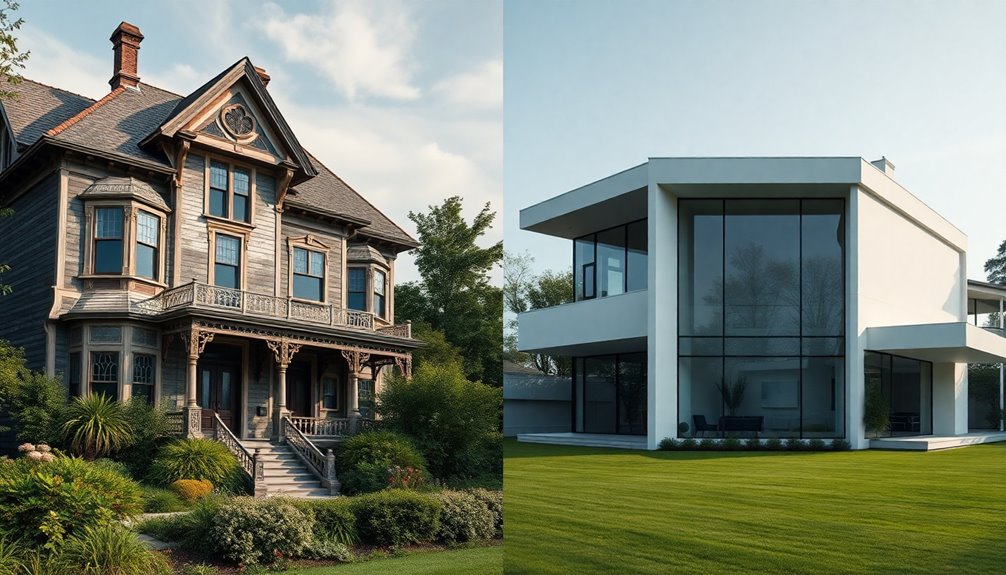
Traditional homes exude a sense of timelessness, showcasing characteristics that reflect their historical roots.
You'll find that these residences feature:
- Distinct Rooms: Compartmentalized layouts promote privacy and cozy environments with specific areas for various functions.
- Rich Textiles and Ornate Furniture: Interiors often highlight heavy, dark wood furniture and vibrant textiles that add warmth and richness.
- Durable Materials and Traditional Design Elements: Built with brick, wood, and stone, traditional homes boast gabled roofs, front-facing porches, and intricate ornamental details.
The emphasis on high-quality woodwork and decorative moldings further enhances their charm, making traditional homes a lasting representation of craftsmanship and design that many still admire today. Additionally, the average divorce costs associated with maintaining a traditional home can influence financial decisions in a marital separation.
Characteristics of Modern Homes
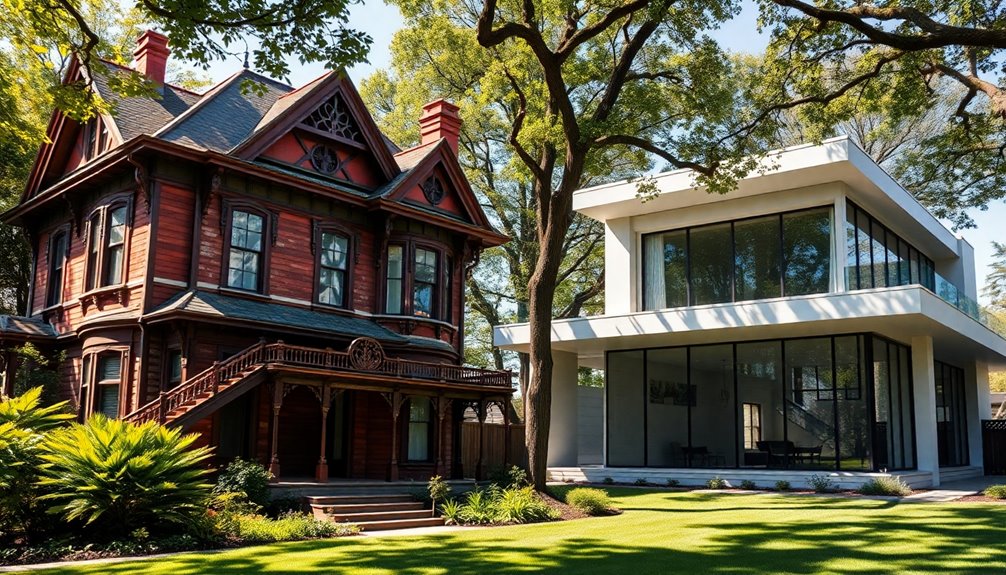
Modern homes showcase minimalist design principles that create a clean and uncluttered aesthetic.
You'll notice open floor plans that enhance the flow of space, making living areas feel more connected and inviting.
Additionally, these homes often incorporate sustainable materials, reflecting a commitment to both style and environmental responsibility.
Minimalist Design Principles
Embracing minimalist design principles, contemporary homes focus on simplicity and functionality, creating spaces that feel both calm and organized.
You'll find that modern design emphasizes:
- Clean lines and a neutral color palette that enhance visual appeal without overwhelming the senses.
- Large windows that invite natural light, promoting energy efficiency and a connection to the outdoors.
- The principle of form follows function, ensuring every element serves a purpose, reducing clutter.
These characteristics foster spatial flow, making areas adaptable to various living needs.
Incorporating natural materials like wood, glass, and concrete maintains a cohesive look while enhancing comfort.
Ultimately, minimalist design in modern homes creates a serene environment that prioritizes both aesthetics and practicality.
Open Floor Plans
In contemporary home design, open floor plans have become a hallmark feature that transforms how you experience space. These layouts eliminate unnecessary walls, enhancing social interaction and maximizing usable space. You'll enjoy multifunctional spaces that accommodate cooking, entertaining, and family gatherings, promoting versatility in your living environment. Additionally, incorporating sustainable materials can further enhance the modern aesthetic while being eco-friendly.
| Feature | Benefits | Considerations |
|---|---|---|
| Open Floor Plans | Enhances spaciousness | May lack privacy |
| Natural Light | Connects indoor and outdoor spaces | Noise control challenges |
| Aesthetic Appeal | Modern and inviting design | Potential distraction |
Modern homes often feature large windows and glass doors, maximizing natural light. While they offer aesthetic appeal and practicality, remember that the absence of compartmentalized rooms can affect your privacy.
Sustainable Material Usage
As you explore the characteristics of contemporary homes, you'll notice a notable shift towards using sustainable materials. This transformation is essential for reducing environmental impact compared to traditional construction.
Here are three key aspects of modern homes:
- Sustainable Materials: Options like bamboo, recycled steel, and reclaimed wood minimize resource depletion.
- Energy-Efficient Insulation: Advanced insulation techniques help optimize heating and cooling, cutting energy costs considerably.
- Eco-Friendly Features: Low-VOC paints and renewable energy sources, such as solar panels, enhance indoor air quality and lower your carbon footprint. Additionally, integrating heat pumps into modern homes can further improve energy efficiency and reduce operational costs.
These sustainable building practices not only align with modern architecture but also promote responsible living, making a positive contribution to global sustainability goals.
Key Differences in Design

When you compare the architectural styles of old and modern houses, you'll notice distinct differences in design.
Old homes boast ornate details and compartmentalized spaces, while modern homes focus on minimalism and open layouts.
This shift in space utilization not only affects aesthetics but also how you interact with your living environment.
Architectural Styles Comparison
While both old and modern houses reflect the values and aesthetics of their times, their architectural styles reveal striking differences in design.
Here are some key comparisons:
- Design Elements: Traditional homes often showcase ornate designs with intricate craftsmanship, while modern homes focus on minimalism and sleek lines.
- Floor Plans: Traditional homes typically feature compartmentalized floor plans with defined rooms, whereas modern homes prefer open-concept layouts that promote social interaction.
- Materials and Efficiency: Traditional architecture uses durable materials like brick and wood, while modern styles incorporate glass and steel, prioritizing energy efficiency and maximizing natural light.
These differences highlight how architectural styles evolve to meet changing needs and preferences in home design.
Space Utilization Differences
Space utilization in homes reveals a significant contrast between traditional and modern designs. While traditional designs feature compartmentalized floor plans with distinct rooms, modern homes offer open-concept layouts that enhance space utilization. You'll find multifunctional spaces in modern homes, adapting easily to your lifestyle, whereas traditional homes often confine you to rigidly defined areas.
| Aspect | Traditional Designs | Modern Homes |
|---|---|---|
| Floor Plan | Compartmentalized | Open-concept |
| Space Efficiency | Less efficient use of space | Efficient use of square footage |
| Indoor & Outdoor Living | Defined separations | Seamless shifts |
| Storage Solutions | Standalone furniture | Built-in, innovative solutions |
These design features promote a more fluid lifestyle, making modern homes ideal for today's needs.
Energy Efficiency Comparisons

As modern houses embrace innovative energy-efficient technologies, they stand in stark contrast to older homes that often struggle with outdated systems.
Here are three key differences in energy efficiency:
- Insulation: Modern homes use advanced insulation materials that optimize heating and cooling, drastically cutting energy consumption compared to traditional homes with outdated insulation methods.
- Renewable Energy: Many modern homes incorporate renewable energy sources like solar panels, promoting sustainable living and reducing long-term utility costs.
- Appliances and Lighting: Energy-efficient appliances and lighting in modern homes conserve energy, while older homes may rely on less efficient options that drive up energy consumption. Additionally, modern systems like heat pumps provide efficient heating and cooling solutions, further enhancing energy savings.
Aesthetic and Cultural Impact
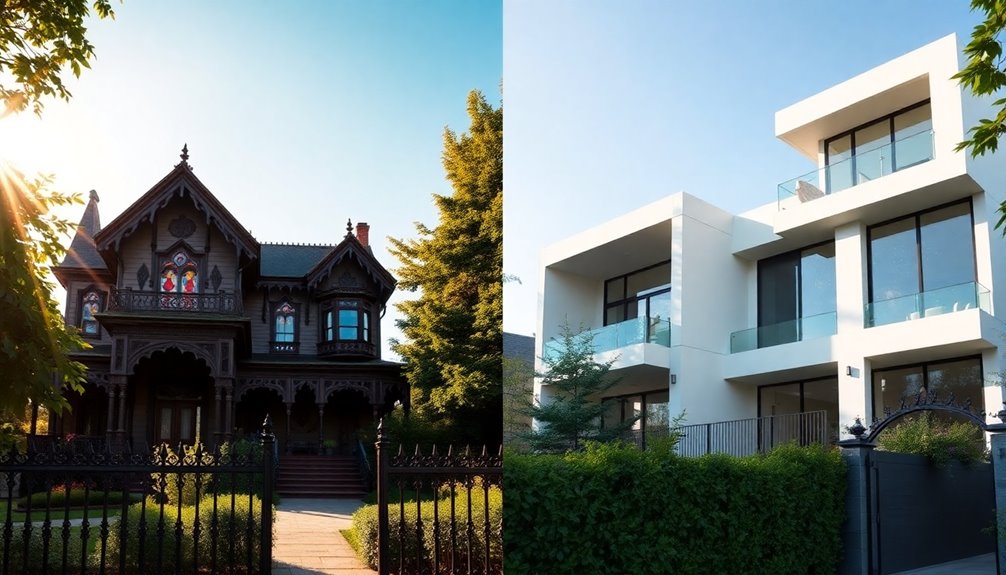
When you explore the aesthetic and cultural impact of homes, you'll find that traditional houses often evoke a sense of nostalgia and historical significance, capturing the essence of cultural heritage. Traditional architectural styles, like Colonial and Victorian, showcase intricate craftsmanship and rich materials. In contrast, modern homes emphasize minimalism and clean lines, reflecting current design trends.
| Traditional Houses | Modern Homes |
|---|---|
| Rich materials (brick, wood) | Focus on functionality |
| Ornate details | Clean, minimalist design |
| Symbolize regional identity | Reflect globalized trends |
| Emphasize historical significance | Foster innovation and sustainability |
Both styles shape community identity, with traditional homes promoting continuity and modern designs encouraging a forward-thinking ethos, sometimes blending into hybrid styles that honor cultural roots while embracing contemporary living.
Choosing a Modern Home
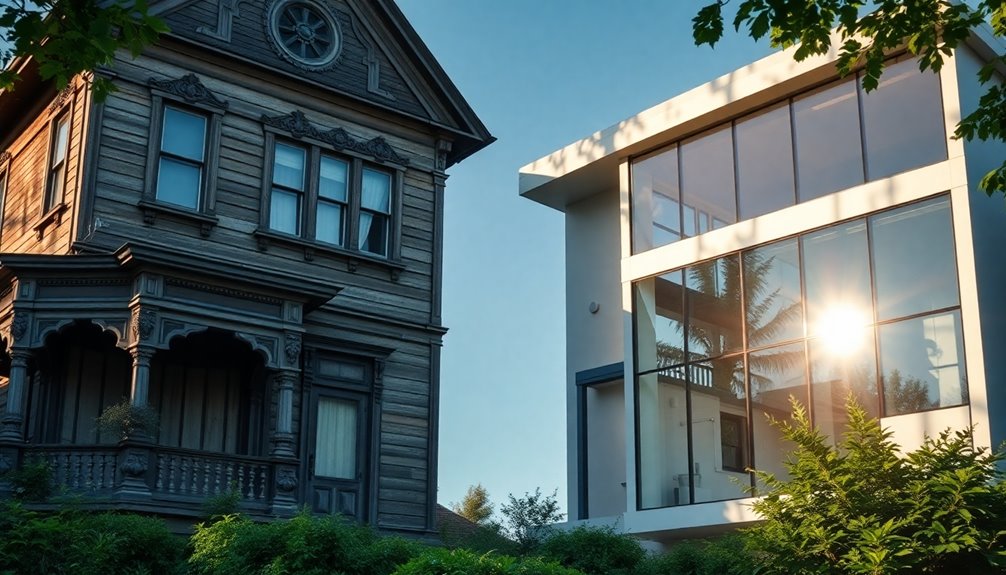
- Natural Light: Large windows and glass doors create a seamless connection with the outdoors, making your home feel spacious and inviting.
- Energy Efficiency: Look for homes that incorporate sustainable materials and smart home technology to lower utility costs and promote eco-friendliness.
- Minimalist Aesthetic: Modern homes emphasize clean lines and a neutral color palette, offering a serene visual appeal. Additionally, consider how natural materials can be integrated into the design to enhance both aesthetics and functionality.
Choosing a modern home means embracing a lifestyle that values flexibility, comfort, and sustainability.
Renovation and Customization Options
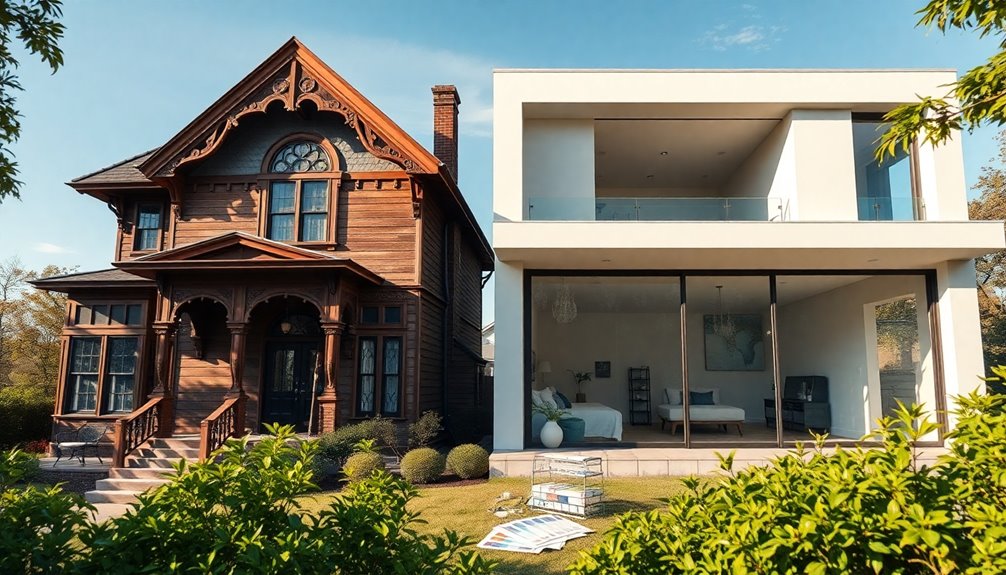
While modern homes offer a plethora of customization options, renovating an old house can blend historical charm with contemporary conveniences. You can preserve unique historical elements while integrating modern amenities that enhance functionality.
Many homeowners focus on energy efficiency by utilizing updated insulation materials and energy-efficient windows. This not only reduces utility costs but also promotes eco-friendly living. Upgrading kitchens and bathrooms is particularly rewarding, as these areas draw potential buyers' attention with their modern design. Additionally, incorporating heat pumps can significantly improve energy efficiency and reduce utility expenses.
Meanwhile, modern homes often feature open floor plans, smart home technology, and sustainable features like solar panels. Whether you choose renovation or customization, both paths lead to creating a space that reflects your lifestyle while balancing history and modernity.
Frequently Asked Questions
What Is the Difference Between Modern and Old Houses?
When you think about modern and old houses, you'll notice some key differences.
Modern houses often feature open floor plans, sleek designs, and energy-efficient materials. In contrast, old houses typically have distinct rooms and intricate details.
You'll find traditional materials like brick and wood in older homes, while modern ones utilize glass and steel. Additionally, modern houses focus on sustainability, incorporating smart technologies that older homes usually lack.
What Are the Two Main Differences Between the Old House and the New House?
When you compare old houses and new ones, two main differences stand out.
First, old houses often feature intricate designs and compartmentalized spaces, while new houses embrace minimalism with open-concept layouts.
Second, modern homes prioritize energy efficiency and smart technology, incorporating materials like glass and steel, whereas older homes typically rely on traditional materials like wood and brick.
These distinctions reflect changing tastes and advancements in architectural design.
What Is the Difference Between an Old and a Modern Building?
When you compare an old building to a modern one, you'll notice distinct differences in design and materials.
Old buildings often feature ornate details and durable materials like brick and wood, while modern structures lean towards minimalism with clean lines and glass.
You'll find old buildings have compartmentalized spaces for privacy, whereas modern buildings embrace open-concept layouts that maximize natural light and energy efficiency, reflecting contemporary living needs and sustainability.
What Is the Difference Between the House Built in the Past and Present?
When you step into a house, do you feel the echoes of history or the pulse of modernity? The difference between houses built in the past and present lies in their essence.
Older homes often showcase intricate craftsmanship and compartmentalized spaces, while today's designs embrace minimalism and open layouts.
You'll find traditional materials like wood and brick contrasted with sleek glass and steel, reflecting our evolving tastes and the push for energy efficiency and smart technology.
Conclusion
In the end, choosing between an old and a modern home is like picking between a classic novel and a contemporary bestseller; each offers its own unique charm. While traditional houses boast timeless character, modern homes shine with sleek designs and energy efficiency. Ultimately, it's about what resonates with you and fits your lifestyle. Whether you're drawn to nostalgia or innovation, you can find a space that feels like home, reflecting your personal story beautifully.


